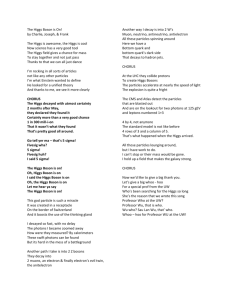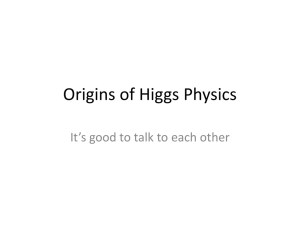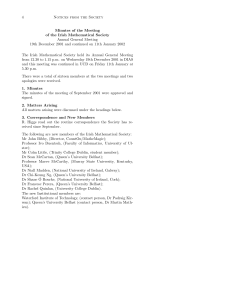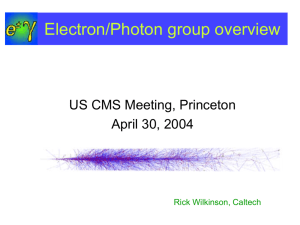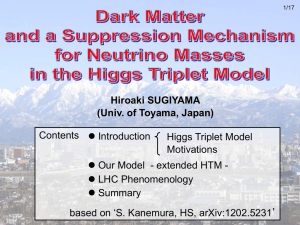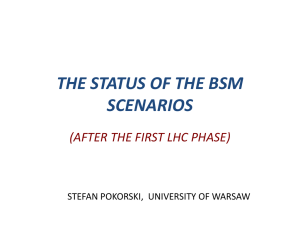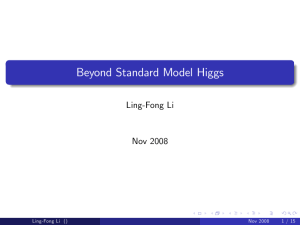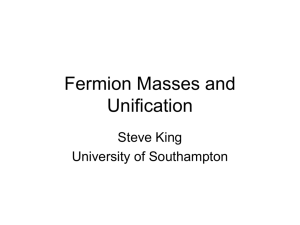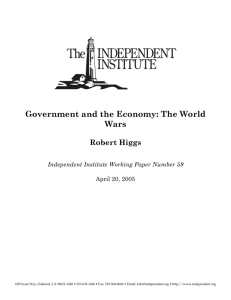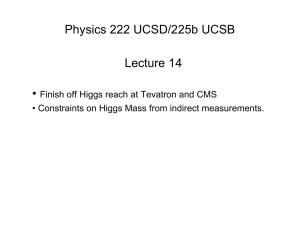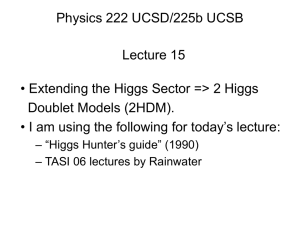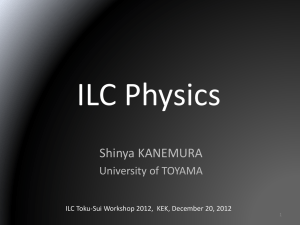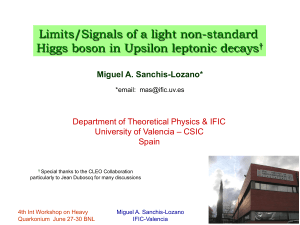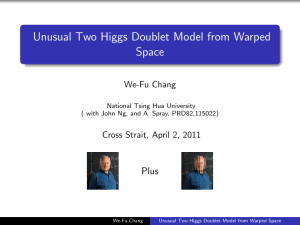Christopher Scales
advertisement
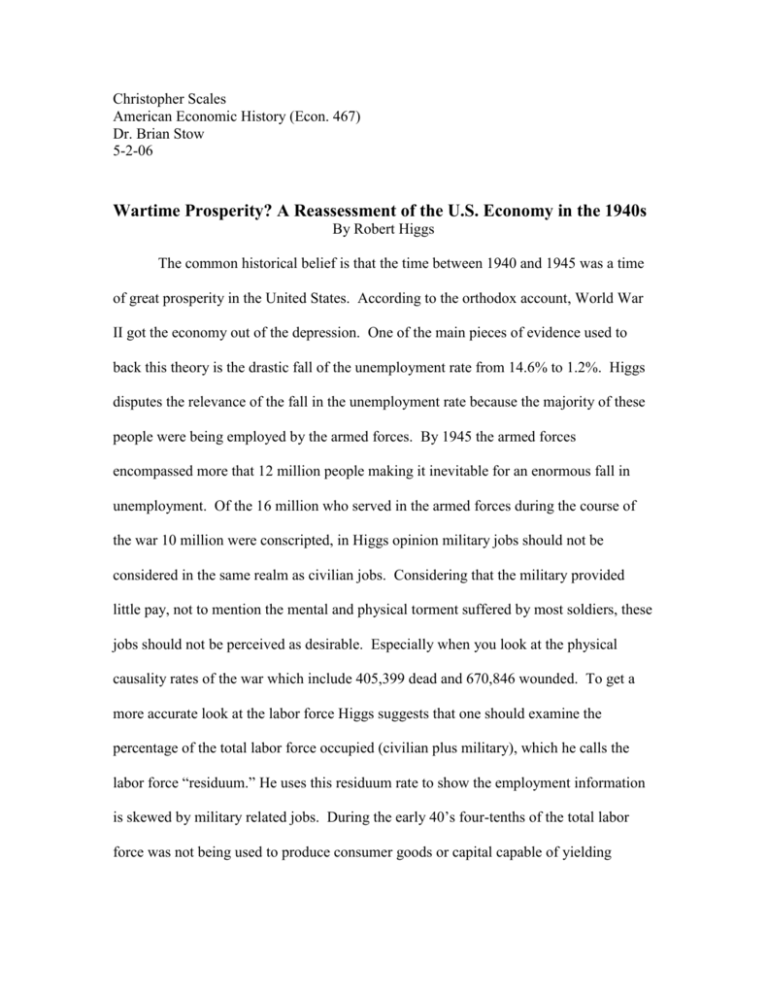
Christopher Scales American Economic History (Econ. 467) Dr. Brian Stow 5-2-06 Wartime Prosperity? A Reassessment of the U.S. Economy in the 1940s By Robert Higgs The common historical belief is that the time between 1940 and 1945 was a time of great prosperity in the United States. According to the orthodox account, World War II got the economy out of the depression. One of the main pieces of evidence used to back this theory is the drastic fall of the unemployment rate from 14.6% to 1.2%. Higgs disputes the relevance of the fall in the unemployment rate because the majority of these people were being employed by the armed forces. By 1945 the armed forces encompassed more that 12 million people making it inevitable for an enormous fall in unemployment. Of the 16 million who served in the armed forces during the course of the war 10 million were conscripted, in Higgs opinion military jobs should not be considered in the same realm as civilian jobs. Considering that the military provided little pay, not to mention the mental and physical torment suffered by most soldiers, these jobs should not be perceived as desirable. Especially when you look at the physical causality rates of the war which include 405,399 dead and 670,846 wounded. To get a more accurate look at the labor force Higgs suggests that one should examine the percentage of the total labor force occupied (civilian plus military), which he calls the labor force “residuum.” He uses this residuum rate to show the employment information is skewed by military related jobs. During the early 40’s four-tenths of the total labor force was not being used to produce consumer goods or capital capable of yielding consumer goods in the future. After 1946 the residuum rate falls from 40.6 to 11.5 showing a genuine return to prosperity. Higgs continues his argument by next attacking the high real gross national product figures from 1940 to 1945. Higgs references studies done by Simon Kuzents, who states that government spending should only be included in GNP if it pays for a flow of goods to consumers or a flow to capital formation. He insisted that military spending should only be included if the money spent contributed to military capital stock, that being durables and construction that could be used for non-military uses. Not everyone accepted this theory. William Nordhaus and James Tobin aimed there sights at eliminating all activities from GNP that they deemed not to be sources of utility. This included all national defense spending. Although they did not consider military spending wasteful, they did classify is as a “necessary regrettable” expense and a intermediate good. Other economist claimed that the index number used to derive the GNP were no longer relevant. Mainly because much of the output during the war, especially weapons, consisted of goods that did not exist before the war. Manufacturing of many important consumer goods were outlawed because the material they required were needed for some aspect in the war and/or were in short supply. Higgs went on to say that it would be impossible to construct a price index of war products that would span both prewar and war years because they did not exist. The next aspect attacked by Higgs is the historical conception that real personal consumption increased during the war. He argues that even thought income and savings of workers went up drastically during this period they could not spend it on the goods they desired because of the non-price rationing of many widely consumed goods. The price indexes used by many historians and economists to derive these clams, according to Higgs, is flawed because they understated the actual inflation during the war and overstated the inflation during the immediate postwar period. More recently Rockoff and Geofrey Mills (by using a different macroeconomic approach) have estimated an alternative deflator for NNP during the war. This new approach shows that the official deflator understated the price level by 2.3% in 1943 up to 4.8% in 1945. According to Higgs the conditions were much worse for consumer during the war than the data suggest. Even if the historical price indexes are correct consumers had to content with other extraordinary welfare-diminishing changes during the war. To get available goods, and jobs people had to move, many of them long distances, to centers of war production. Not only were these people susceptible to bearing sustainable relocation costs, once there they had to deal with poor/overcrowded housing, along with transportation problems caused by car shortages. Any many places prices for goods were increased dramatically because of the black markets that arouse from shortages. This is made even more prevalent by the government slogan for the time, “use it up, wear it out, make it do, or do with out.” In thousands of ways consumers lost their freedom of choice due to war time policy. During this period many teenagers left school, women left their homes, and older people left retirement to work. The civilian employment of people 14 years of age or older increased from 47.6% in 1940 to 57.9% in 1944. The average manufacturing work week went from 38.1 hours in 1940 to 45.2 hours in 1944, in the bituminous coal mining industry alone average work times increased by 50%. Night time shifts occupied a much larger portion of the work force and disabling injuries per hour worked in manufacturing rose by more than 30% between 1940 and the wartime peak of 1943. Higgs goes on to say that it is hard to understand how working harder, longer, more inconveniently and dangerously in return for a diminished flow of consumer goods supports the statement the economically speaking, “Americans had never had it so good.” The main reason the standard macroeconomic models employed to account for the wartime experience do not do and acceptable job in they do not pertain to a command economy. All standard macro models presume the existence of functioning markets for commodities, factor services, and bonds. During this time period the government controlled and regulated everyone one of these sectors with numerous price controls, rationing, and in some cases the outright prohibition in the consumer goods markets. Taxes were raised, many forms of production received subsidies, and credit markets came under total control causing many restrictions. In summary the economy during the war was the exact opposite of a free market system. Government had its hand in every aspect of the economy and in most situations was highly regulated and controlled. During the war real gross private domestic investment plunged by 64%. In summary World War II got the US economy out of the Great Depression but not in the way described by orthodox story. The war economy itself did not get the economy out a depression nor did it produce a “carnival of consumption” or an investment boom. But the war did manage to cause a build up in personal financial wealth along with the transformation of expectations for the citizens of the country. So when the war ended the real prosperity returned to the country when the control economy was terminated and the free market system was allowed to become president once again.

